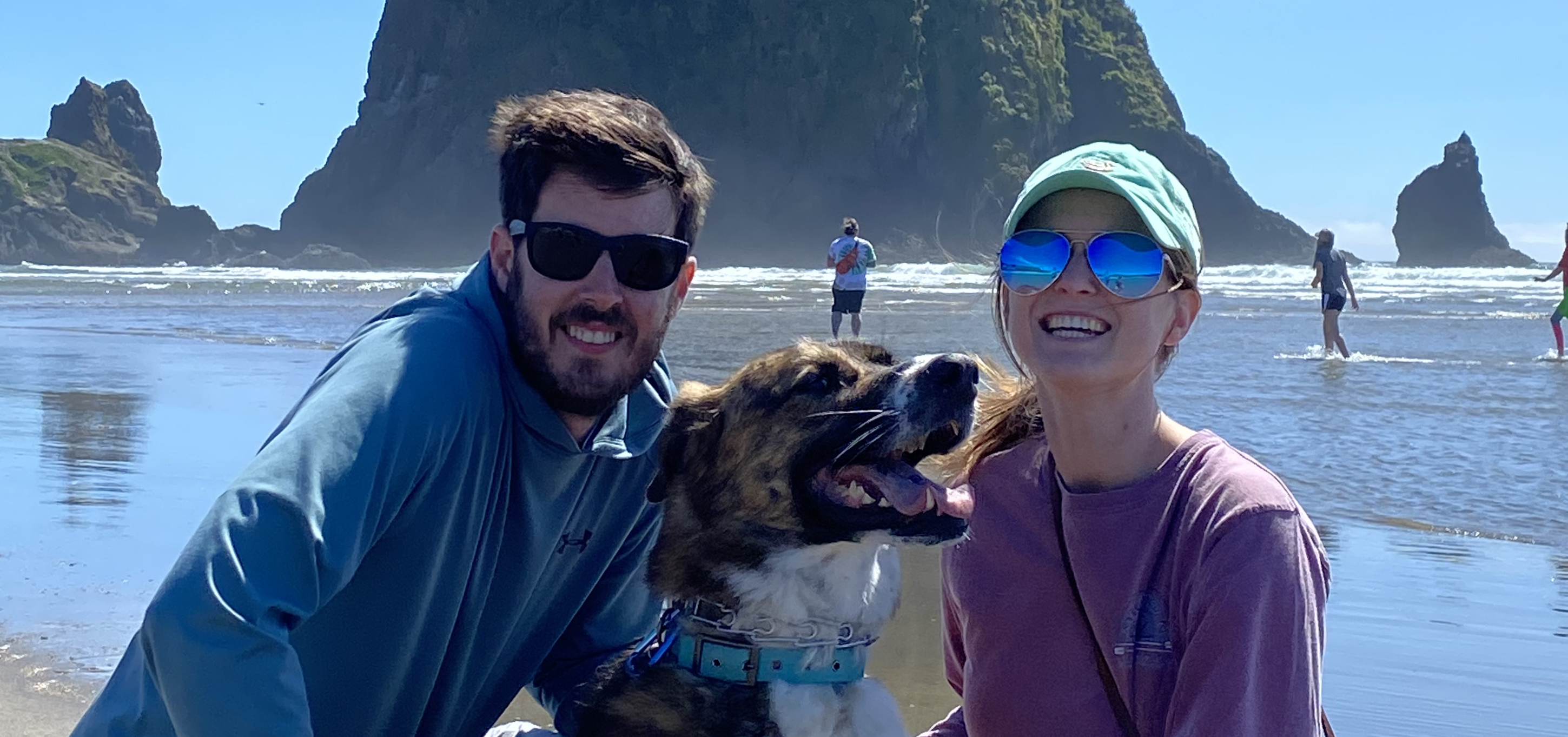Dr. Rachael Gruenwald (right), husband Brett and dog Loki enjoying a beautiful day on the Oregon Coast. Dr. Gruenwald is an assistant professor of anatomic pathology at the Oregon Veterinary Diagnostic Laboratory at the Oregon State University Carlson College of Veterinary Medicine.
Dr. Rachael Gruenwald is an assistant professor of anatomic pathology at the Oregon Veterinary Diagnostic Laboratory at the Oregon State University Carlson College of Veterinary Medicine.
What is your role within the Oregon Veterinary Diagnostic Laboratory?
I'm a veterinary anatomic pathologist which is a dynamic role that blends diagnostics, teaching and research, so it’s rarely boring.
I work on biopsy and necropsy cases across a wide range of species to help identify disease processes, and I like being able to use that information to help clinical veterinarians treat their patients, give answers to pet owners, support farmers and ranchers and protect both animal and human health.
I also teach veterinary students and residents in the lecture hall and on the necropsy floor, helping to build the foundational knowledge of pathology that every veterinarian needs.
Currently, I’m excited to be expanding my ocular pathology diagnostic service, in which I do gross evaluation of the globe and provide detailed histopathologic evaluations of the eye for general practitioners and veterinary ophthalmologists throughout the region. Eyes are incredibly complex and elegant structures, and I love collaborating with clinicians on ocular disease.
What drew you to this field?
I originally thought I’d be a mixed animal practitioner, and during vet school, I started attending gross pathology rounds so I’d be better equipped to diagnose and treat the wide range of cases that might walk into my future clinic. That’s when I realized that figuring out how and why diseases happen — and getting to see the pathology firsthand — was my favorite part of clinical work. I loved the hands-on aspect, the problem-solving, and the opportunity to teach. I was a tutor throughout vet school and knew that education would always be part of my career. Pathology brought everything I loved together: the excitement of disease discovery, the challenge of diagnostics and the joy of teaching. Once I realized what I wanted to be when I grew up, I started focusing more on anatomic pathology and pursued residency training after vet school.
What is your favorite part about your job, and why?
The OVDL works with a broad spectrum of clients including general practices, specialty clinics, zoos, wildlife centers and researchers, which allows us to work with a wide variety of species and diseases. That diversity keeps the cases both challenging and rewarding. But my favorite ones are ocular cases. The eye is its own little organ system, and it offers a unique diagnostic window into both localized and systemic disease. I enjoy diagnosing primary ocular conditions such as goniodysgenesis or feline diffuse iris melanoma, but I may also find evidence in the eye that points to larger systemic issues such as bacterial or fungal infections, immune-mediated disease or metastatic cancer.
What’s one thing you wish people knew about your job?
Pathologists are often the “people behind the curtain.” We work in the background quietly safeguarding animal and public health. While people may not know about us, our role is essential — especially in detecting and responding to outbreaks of zoonotic disease. Veterinary diagnostic labs like the OVDL — including the bacteriologists, virologists, technicians, and support staff — are critical to pandemic preparedness. Whether it's tracking unusual disease patterns or diagnosing the first signs of a regional outbreak, our work plays a critical role in protecting both animal and public health.
What's the most interesting case you've worked on and why?
Oh gosh. There are too many to pick from. Probably a case of Yersinia pestis, which is the bacteria that causes plague, in a house cat. The case was fascinating both pathologically and from a public health perspective. Not only was it a rare diagnosis in a cat, but the owner had also fallen ill and was infected with the same bacteria. It became a collaborative effort between our lab, public health officials and the veterinary clinic. Getting to see the lesions firsthand and help confirm a zoonotic transmission was a powerful reminder of how interconnected animal and human health are.
Do you have any hidden talents or unique hobbies? Share them with us!
I love playing both indoor and sand volleyball, usually sixes, but doubles with my husband is my favorite. When I’m not at the net, I’m out on the trails hiking, especially at Silver Falls or along the McKenzie River. I also love checking out tide pools along the Oregon coast and hunting down hidden gem restaurants. I have a deep appreciation for ice cream, but my true frozen dessert love is frozen custard. Back when I lived in Missouri, I could do a blind taste test and tell you which creamery made the custard. It was a very niche (and delicious) party trick. Now that I’m in Oregon, I guess it’s time to start “training” with local ice creams.










